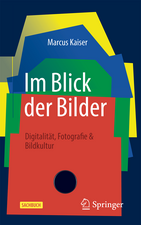Fast Design, Slow Innovation: Audiophotography Ten Years On
Autor David M. Frohlichen Limba Engleză Hardback – 6 ian 2016
The capture of photographs with sound is a simple idea, proposed 10 years ago, that has still not become widespread. In this new edition of the seminal 2004 book on Audio photography, the author asks “Why?” A journey through the book’s citations and related commercial products shows considerable progress in understanding the role of sound in photography, and myriad design experiments to support audio visual storytelling as a new media form. The book is a story in itself about the “long nose of innovation”, and a lesson about the need for patience and persistence in the computer industry. To reinforce this point five of the 2004 chapters are re-published in their original form. These describe invariant properties of ambient musical, talking and conversational photographs, and the possibility of playback from paper as well as screen.
Fast Design, Slow Innovation will be of interest to researchers and designers of new media systems and experiences, and to innovation scholars or managers looking for a ten year case study of innovation in action.
| Toate formatele și edițiile | Preț | Express |
|---|---|---|
| Paperback (1) | 330.10 lei 6-8 săpt. | |
| Springer International Publishing – 30 mar 2018 | 330.10 lei 6-8 săpt. | |
| Hardback (1) | 336.35 lei 6-8 săpt. | |
| Springer International Publishing – 6 ian 2016 | 336.35 lei 6-8 săpt. |
Preț: 336.35 lei
Preț vechi: 420.43 lei
-20% Nou
Puncte Express: 505
Preț estimativ în valută:
64.36€ • 67.20$ • 53.15£
64.36€ • 67.20$ • 53.15£
Carte tipărită la comandă
Livrare economică 16-30 aprilie
Preluare comenzi: 021 569.72.76
Specificații
ISBN-13: 9783319219387
ISBN-10: 3319219383
Pagini: 231
Ilustrații: XIV, 231 p. 102 illus., 73 illus. in color.
Dimensiuni: 155 x 235 x 16 mm
Greutate: 0.53 kg
Ediția:1st ed. 2015
Editura: Springer International Publishing
Colecția Springer
Locul publicării:Cham, Switzerland
ISBN-10: 3319219383
Pagini: 231
Ilustrații: XIV, 231 p. 102 illus., 73 illus. in color.
Dimensiuni: 155 x 235 x 16 mm
Greutate: 0.53 kg
Ediția:1st ed. 2015
Editura: Springer International Publishing
Colecția Springer
Locul publicării:Cham, Switzerland
Public țintă
ResearchCuprins
Preface.- Acknowledgements.- Introduction.- Part I: Audiophotography Defined.- Ambient Photographs.- Ambient Photographs.- Talking Photographs.- Conversational Photographs.- Paper Versus Screen Playback.- Part II: What Happened Next?.- Research and Development Within HP.- External Research.- External Development.- Lessons.- Index
Textul de pe ultima copertă
As well as updating the manifesto for an audio photography technology and practice, this book addresses issues in design history, the social shaping of technology and the management of innovation. In particular, it reveals the very different timescales over which design and innovation operate, and the way in which design ideas evolve across different research groups, companies and application areas.
The capture of photographs with sound is a simple idea, proposed 10 years ago, that has still not become widespread. In this new edition of the seminal 2004 book on Audio photography, the author asks “Why?” A journey through the book’s citations and related commercial products shows considerable progress in understanding the role of sound in photography, and myriad design experiments to support audio visual storytelling as a new media form. The book is a story in itself about the “long nose of innovation”, and a lesson about the need for patience and persistence in the computer industry. To reinforce this point five of the 2004 chapters are re-published in their original form. These describe invariant properties of ambient musical, talking and conversational photographs, and the possibility of playback from paper as well as screen.
Fast Design, Slow Innovation will be of interest to researchers and designers of new media systems and experiences, and to innovation scholars or managers looking for a ten year case study of innovation in action.
The capture of photographs with sound is a simple idea, proposed 10 years ago, that has still not become widespread. In this new edition of the seminal 2004 book on Audio photography, the author asks “Why?” A journey through the book’s citations and related commercial products shows considerable progress in understanding the role of sound in photography, and myriad design experiments to support audio visual storytelling as a new media form. The book is a story in itself about the “long nose of innovation”, and a lesson about the need for patience and persistence in the computer industry. To reinforce this point five of the 2004 chapters are re-published in their original form. These describe invariant properties of ambient musical, talking and conversational photographs, and the possibility of playback from paper as well as screen.
Fast Design, Slow Innovation will be of interest to researchers and designers of new media systems and experiences, and to innovation scholars or managers looking for a ten year case study of innovation in action.
Caracteristici
Reviews the role of sound in photography after ten years of innovation in the field Traces the evolution of design ideas across individuals and companies, through the backwaters of old technologies to the estuaries of new ones Illustrates the interplay between research and development in the computer industry during the birth of a new medium



![Adobe Flash Professional CS5 Classroom in a Book: The Official Training Workbook from Adobe Systems [With DVD ROM]](https://i0.books-express.ro/bt/9780321701800/adobe-flash-professional-cs5-classroom-in-a-book.jpg)















